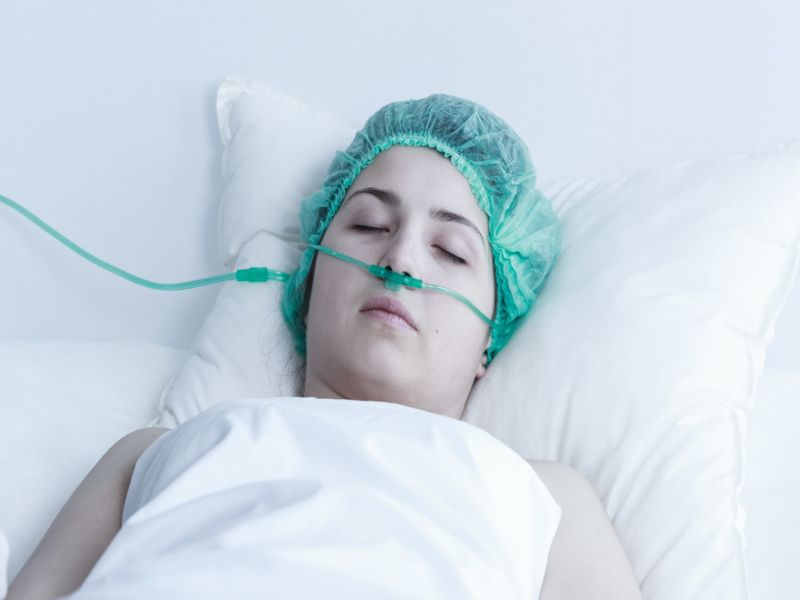By Dennis Thompson
HealthDay Reporter

WEDNESDAY, June 26, 2019 (HealthDay News) -- Doctors typically test the consciousness of brain-injured patients with verbal commands -- asking them to move a hand or wiggle a toe, for example.
Those who don't respond are considered "unresponsive." They could spend weeks or months languishing in a coma, and perhaps never wake up at all.
But a new study argues that there's a good chance that this initial test of consciousness is flawed, and could be overlooking some patients who stand a better chance of recovery.
Instead, electroencephalograpy (EEG) can reveal hidden consciousness in some brain-injured patients who appear unresponsive to commands, and those patients appear to be more likely to eventually wake up and get better, researchers report.
"Many patients in the ICU do not show movements on commands and typically this is interpreted as unconsciousness," said lead researcher Dr. Jan Claassen, head of neurocritical care at Columbia University Medical Center in New York City. "But some of these patients have brain activation in response to those commands, raising the possibility of some preservation of consciousness."
Families armed with this knowledge could be able to make better choices for the future treatment of their comatose loved one, said Dr. Neha Dangayach, director of neuroemergencies management and transfers for the Mount Sinai Health System in New York City. She wasn't involved with the study.
"I think this is perhaps going to be useful when we are trying to provide prognostications, and maybe this should added to monitoring for all patients in a coma," Dangayach said.
The info could even help inform the toughest decision of all, whether to pull the plug on a loved one in a vegetative state, researchers said.
Prior research has shown that about 14% of unresponsive comatose patients do show signs of hidden consciousness, with their brain patterns changing in response to a verbal command even if they don't move their body, researchers said in background notes.
"There is increasing clinical recognition that when patients with a perceived devastating brain injury come in to the ICU, our immediate judgments may well be imperfect," said Dr. David Menon, head of anesthesia at the University of Cambridge in the United Kingdom.
But it hasn't been clear whether those patients have a better chance of recovery compared with those whose brain waves don't show any response to verbal commands.
Looking for signs in brain patterns
To investigate this further, Claassen and his team studied 104 ICU patients who'd recently sustained a brain injury due to trauma, stroke or some other cause.
None of the patients were paralyzed, but they were unable to talk and did not respond to commands to move.
The research team performed daily neurologic exams of the patients, hooking each up to an EEG and asking them to move their bodies. The EEG data was gathered and run through a computer to look for signs hidden in brain patterns that a patient had heard the command but was unable to perform the movement.
Within four days of their brain injury, about 15% of the unresponsive patients had brain activity patterns suggesting that they were mentally responding to the commands, researchers found.
Among patients with those patterns, half improved and eventually were able to follow verbal commands by the time they left the hospital, versus a quarter of those without such brain activity.
Follow-up a year later revealed that 44% of patients who'd shown signs of hidden consciousness were able to function independently for up to eight hours each day, compared with only 14% of those without such early signals.
The findings were published June 27 in the New England Journal of Medicine.
"Those patients who showed on their EEG evidence of attempting to respond to instructions had about a threefold increase in recovery rates," noted Menon, co-author of an editorial accompanying the new study.
However, patients with brain activity did not have a survival advantage over those without. About one-third of patients in both groups died.
Clearer information would help families
Using an EEG to suss out hidden signs of consciousness might not directly influence how a patient will recover, but it could provide doctors and families with more information upon which to make crucial decisions, Menon said.
"Given enough time, outcomes will declare themselves, but it would be helpful for clinicians and patients' families to have a more accurate early indication of eventual outcome," Menon said. "This may also allow us to select patients for drug treatments that accelerate emergence from coma."
It would be easy enough to add such EEG monitoring to a patient's regular care, Claassen said. The devices already are commonly used in ICUs to monitor patients at risk for seizures.
"Though our study was small, it suggests that EEG -- a tool that's readily available at the patient's bedside in the ICU in almost any hospital across the globe -- has the potential to completely change how we manage patients with acute brain injury," Claassen said.
Dangayach warned that despite these findings, patients without such brain activity should not be written off. She noted that about 1 in every 7 patients without these brain signals still went on to have a meaningful recovery.
"It's not specific for us to rule out patients who might still have a good prognosis," Dangayach said.
Claassen said researchers hope to keep fine-tuning the EEG test through a larger independent study, in hopes that "it could be integrated into clinical practice in the future."
More information
The Mayo Clinic has more about coma.
Back

The news stories provided in Health News and our Health-E News Newsletter are a service of the nationally syndicated HealthDay® news and information company. Stories refer to national trends and breaking health news, and are not necessarily indicative of or always supported by our facility and providers. This information is provided for informational and educational purposes only, and is not intended to be a substitute for medical advice, diagnosis, or treatment.






